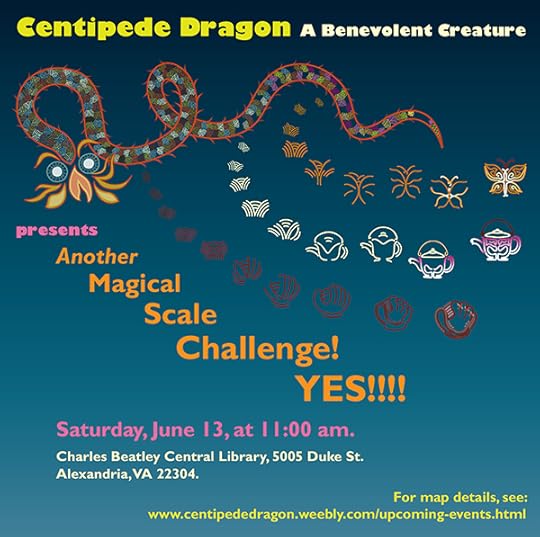Alice Y. Chen's Blog, page 10
May 21, 2015
Loose (noodle) ends
It was brought to my attention that I neglected to answer a question I posed from week 2 of Asian American and Pacific
Islander Heritage Month. The question was: what food would NOT be eaten during the Lunar New Year celebrations, and it
had to do with a color that is associated with death for many Asian Cultures. One person guessed eggs, flour, and, er, SNOW (Um, we don't really EAT snow, though it's acceptable to do so!). She was on the right track, in that this food is white, or very
pale beige....
So the answer is tofu. But not ALL tofu is bad luck. Just the plain, uncooked variety. There are some tofus, like the fermented stuff, that is brown on the outside and pressed in a way to give it much more density, that is actually considered lucky, because it has the same shape as money! Gosh, it's seems like it's ALL about the looks, eh?

Islander Heritage Month. The question was: what food would NOT be eaten during the Lunar New Year celebrations, and it
had to do with a color that is associated with death for many Asian Cultures. One person guessed eggs, flour, and, er, SNOW (Um, we don't really EAT snow, though it's acceptable to do so!). She was on the right track, in that this food is white, or very
pale beige....
So the answer is tofu. But not ALL tofu is bad luck. Just the plain, uncooked variety. There are some tofus, like the fermented stuff, that is brown on the outside and pressed in a way to give it much more density, that is actually considered lucky, because it has the same shape as money! Gosh, it's seems like it's ALL about the looks, eh?

Published on May 21, 2015 10:25
May 19, 2015
Asian American and Pacific Islander Heritage month-The biggest celebration of them all.
For this 3rd week in May, I want to correct myself in saying that this month’s proper titling is “Asian American AND PACIFIC ISLANDER heritage month.” Very sorry for the mistake!
Now, let’s talk about the most important holiday that many Asian cultures celebrate: The Lunar New Year.
The rise of the Chinese in the world economy has increased the western world’s awareness of the mass migration that the Chinese undertake from the cities where they work to the country where their families live.
This holiday of dragon dances, firecrackers, superstitions and symbolic foods, is highly scripted. On each day of the 15 days, certain family members are honored, and certain foods are eaten. Superstitions surrounding the cleaning of the house, preparing and displaying the food offerings to ancestors, and meal preparation and presentation are strictly followed, so as not to introduce an opportunity for bad luck of any kind (e.g. no money, no children, no family happiness) for the coming year.
The holiday period ends in the Lantern festival, which is steeped in mythological origin. It was said that a beautiful bird from heaven was destroyed by villagers in a village. The Jade Emperor saw this and condemned the village to be destroyed.
His daughter, the princess, took pity and tipped the villagers’ off to their fate. An old man passing through the village wisely advised them to hang lanterns, burn fires, and set off fireworks, so that from the sky above, the village looked to already be engulfed in flames. So the Jade Emperor left the village alone thinking it to be destroyed, and the village was saved!
This tale may sound a little corny, but many traditions, western or eastern, are rich in these captivating tales. The themes behind celebrations are universal regardless of WHO we are: life, our respective cultures, and to hope for a good future. The differences come in HOW we do it, so in the end, does it matter if I celebrate by eating chicken feet, or chicken drumsticks? The bottom line is that we all celebrate inherently for the same reasons.

Now, let’s talk about the most important holiday that many Asian cultures celebrate: The Lunar New Year.
The rise of the Chinese in the world economy has increased the western world’s awareness of the mass migration that the Chinese undertake from the cities where they work to the country where their families live.
This holiday of dragon dances, firecrackers, superstitions and symbolic foods, is highly scripted. On each day of the 15 days, certain family members are honored, and certain foods are eaten. Superstitions surrounding the cleaning of the house, preparing and displaying the food offerings to ancestors, and meal preparation and presentation are strictly followed, so as not to introduce an opportunity for bad luck of any kind (e.g. no money, no children, no family happiness) for the coming year.
The holiday period ends in the Lantern festival, which is steeped in mythological origin. It was said that a beautiful bird from heaven was destroyed by villagers in a village. The Jade Emperor saw this and condemned the village to be destroyed.
His daughter, the princess, took pity and tipped the villagers’ off to their fate. An old man passing through the village wisely advised them to hang lanterns, burn fires, and set off fireworks, so that from the sky above, the village looked to already be engulfed in flames. So the Jade Emperor left the village alone thinking it to be destroyed, and the village was saved!
This tale may sound a little corny, but many traditions, western or eastern, are rich in these captivating tales. The themes behind celebrations are universal regardless of WHO we are: life, our respective cultures, and to hope for a good future. The differences come in HOW we do it, so in the end, does it matter if I celebrate by eating chicken feet, or chicken drumsticks? The bottom line is that we all celebrate inherently for the same reasons.

Published on May 19, 2015 05:43
May 12, 2015
May is Asian American Heritage Month, 2
Next off is my favorite topic: how Asian cultures use food in celebrations. Many Asian cultures choose foods to be eaten during the Lunar New Year, the most important holiday for them, because their names sound similar to words like luck, fortune, fertility, prosperity, happiness, etc.
For instance, the word for fish sounds similar to “surplus” or “excess,” and therefore, fish is featured heavily during the holidays. The fish is prepared whole, with its head pointed towards guests or elders. It is presented as a last course and NOT meant to be eaten, or only half-eaten, so as to symbolize the continual abundance of food throughout the year.
The word for pomelo, a grapefruit-like fruit, sounds similar to the verb, “to have,” and thus represents fertility.
The shape or color of food itself can also lend meaning. For example, the dumpling shape is similar to ancient gold and silver ingots.
And long skinny noodles symbolize a long life, thus the strands are never cut!
Some foods look AND sound lucky. Oranges are golden and sunny in color, thus represent good fortune. But its name also sounds like “success.”
And the steamed, sweet, sticky rice-based cake called “nian-gao” symbolizes a rich, sweet life because it is rich and sweet. Furthermore, the name sounds like the phrase, “Getting higher year by year,” and thus signifies prosperity.
Finally, there’s shrimp and chicken. Shrimp symbolize liveliness, while a whole chicken (A lot of foods are served whole to symbolize unity in the family) is thought to be symbolic of the dragon and the phoenix combined. It represents happiness in marriage and family, prosperity and joy.
So, can anyone guess what might NOT be served during the Lunar New Year? A hint: it’s based on an unlucky wedding color I mentioned in last week’s post!
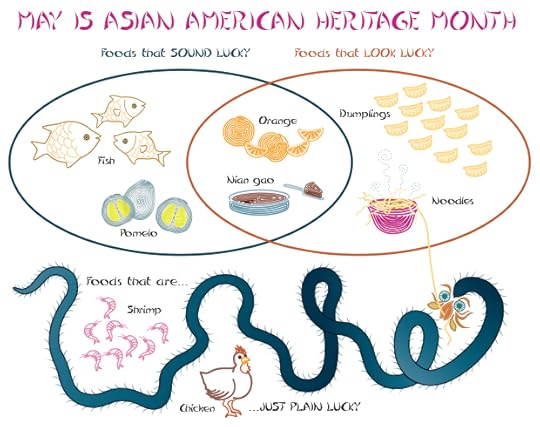
For instance, the word for fish sounds similar to “surplus” or “excess,” and therefore, fish is featured heavily during the holidays. The fish is prepared whole, with its head pointed towards guests or elders. It is presented as a last course and NOT meant to be eaten, or only half-eaten, so as to symbolize the continual abundance of food throughout the year.
The word for pomelo, a grapefruit-like fruit, sounds similar to the verb, “to have,” and thus represents fertility.
The shape or color of food itself can also lend meaning. For example, the dumpling shape is similar to ancient gold and silver ingots.
And long skinny noodles symbolize a long life, thus the strands are never cut!
Some foods look AND sound lucky. Oranges are golden and sunny in color, thus represent good fortune. But its name also sounds like “success.”
And the steamed, sweet, sticky rice-based cake called “nian-gao” symbolizes a rich, sweet life because it is rich and sweet. Furthermore, the name sounds like the phrase, “Getting higher year by year,” and thus signifies prosperity.
Finally, there’s shrimp and chicken. Shrimp symbolize liveliness, while a whole chicken (A lot of foods are served whole to symbolize unity in the family) is thought to be symbolic of the dragon and the phoenix combined. It represents happiness in marriage and family, prosperity and joy.
So, can anyone guess what might NOT be served during the Lunar New Year? A hint: it’s based on an unlucky wedding color I mentioned in last week’s post!

Published on May 12, 2015 06:04
May 7, 2015
May 5, 2015
Did you know it’s Asian-American Heritage Month?
ARE YOU READY FOR THIS?
May is Asian-American Heritage Month, and I want to take advantage of this to talk about some cultural differences such as important holidays, superstitions and food. Too often, these differences make us feel like the cultural gulf is too wide, for just as westerners are accustomed to wearing a white wedding gown to symbolize purity and chastity, wearing white symbolizes death in certain Asian cultures. It’s simply a difference, and should NOT separate, but rather define, our individual heritages. So as we raise our margaritas up on Cinco de Mayo, please give one shout out to Asian American Heritage Month! Rolls off the tongue, eh?
I’ll start off with the significance of dragons in the Chinese culture in particular. The Chinese believed they were the "descendants of the dragon,” and since Centipede Dragon is half-DRAGON, this is a logical place to start.
The dragon is an amalgamation of body parts from nine animals: a deer, a camel, the devil (that’s no animal!), a snake, a large cockle, a carp, an eagle, a tiger and an ox.
The dragon is symbolic of kindness, friendliness, wisdom and is a protector. It is the ultimate symbol of good fortune.
Dragons were thought to control when and where rain would fall, and hence, the success of a crop growth. With strength in its tail, dragons could control floods with one mighty smack upon a river bed!
And finally, the coming of two dragons together in opposite directions form the yin yang sign, a sign marking eternity.
During the Lunar New Year celebration, firecrackers are thrown at the feet of dragon puppets during parades to keep the dragons awake in order to continue bringing good fortune throughout the coming year!
If anyone has anything else to add to the dragon's symbolism, let me know. we'll continue on with more facts throughout this month.
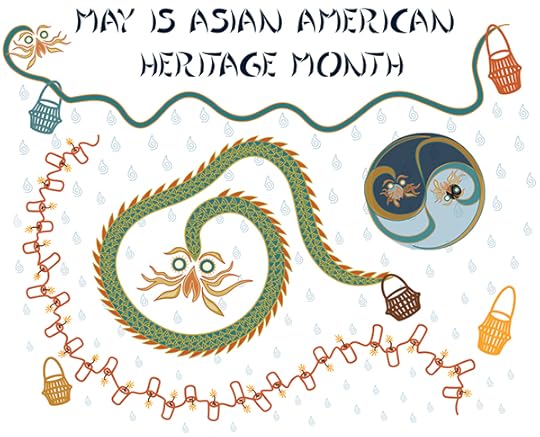
May is Asian-American Heritage Month, and I want to take advantage of this to talk about some cultural differences such as important holidays, superstitions and food. Too often, these differences make us feel like the cultural gulf is too wide, for just as westerners are accustomed to wearing a white wedding gown to symbolize purity and chastity, wearing white symbolizes death in certain Asian cultures. It’s simply a difference, and should NOT separate, but rather define, our individual heritages. So as we raise our margaritas up on Cinco de Mayo, please give one shout out to Asian American Heritage Month! Rolls off the tongue, eh?
I’ll start off with the significance of dragons in the Chinese culture in particular. The Chinese believed they were the "descendants of the dragon,” and since Centipede Dragon is half-DRAGON, this is a logical place to start.
The dragon is an amalgamation of body parts from nine animals: a deer, a camel, the devil (that’s no animal!), a snake, a large cockle, a carp, an eagle, a tiger and an ox.
The dragon is symbolic of kindness, friendliness, wisdom and is a protector. It is the ultimate symbol of good fortune.
Dragons were thought to control when and where rain would fall, and hence, the success of a crop growth. With strength in its tail, dragons could control floods with one mighty smack upon a river bed!
And finally, the coming of two dragons together in opposite directions form the yin yang sign, a sign marking eternity.
During the Lunar New Year celebration, firecrackers are thrown at the feet of dragon puppets during parades to keep the dragons awake in order to continue bringing good fortune throughout the coming year!
If anyone has anything else to add to the dragon's symbolism, let me know. we'll continue on with more facts throughout this month.

Published on May 05, 2015 05:52
April 24, 2015
The waiting game, part 2

During the months I waited while the publishing companies reviewed my book, I was definitely keeping busy. In my other life as a medical illustrator, I was bolstering my animation portfolio, looking for more clients, and keeping my own visual communication skills up. I made up projects for myself, volunteering people I knew who had advanced science degrees to help me check the science, and then executed the projects. You can see and have been reading my busy-bee-ness at my vimeo and facebook pages. And that only tells half the story, honestly.
I remember one time getting a notice for registered mail. Now, I NEVER get registered mail, but this one happened to come at about the time one waiting period was coming to an end. I convinced myself it could BE the letter of acceptance I had been dreaming about and longing for. I ruled out every other possibility: being sued, being served a subpoena, winning Publishers’ Clearinghouse, being called to jury duty….So I logically concluded it was a letter saying my book was to be published AND given a bazillion-dollar budget for marketing alone.
You all know I self-published and that it was NOT that coveted letter. The reason I tell this story is to help you understand the agony and devastation we artists feel when our work is “rejected.” We do want the feedback and we strive to perfect our work, but these pieces, whether written, illustrated or both, are truly our blood, sweat and tears. Which is to say, they are a piece of us.
So, these waiting periods become unbearable at times. This does sound melodramatic, but it’s a simple fact I wish didn't affect me. What I do do well is move on. There’s one piece of advice I am good at following!
Published on April 24, 2015 05:53
April 23, 2015
Killing time
SCBWI members and speakers alike have emphasized that once you’ve submitted your work to a publisher, move on to the next work. Move on to writing something new. Move on to illustrating something else. Just move on.
I partly agree with the “move on” advice. But instead of moving on to the next piece (because if one does not have a next piece, this can compound one's discouragement), move on to the next round of submissions. What could be better than to see on your to-do list, “Go to Barnes and Noble, sit on floor, look through latest end-cap children’s books;” or, “Go to indie bookstore for children’s story time,” or “Go to event featuring so-and-so author or illustrator.” These are no-brainer “to-do’s”.
In my case, I moved on to working on one element in an illustration that wasn’t totally satisfactory. When I was roughing out this image to show Centipede Dragon getting sick, my medical illustrator training taught me that when highlighting a difference over time (or with different parameters), keep everything else in the scene constant. So I copied and pasted the same tail image three times, only with fewer and fewer scales on each successive scenario, to convey the idea that as he’s frantically helping, his scales are rapidly disappearing.
In further developing his character, I realized I hadn't given him much variation in facial expression throughout the book. This makes him somewhat flat, and when you develop a bond with a character, it’s because you get to KNOW him/her through his/her thoughts/feelings. But if Centipede Dragon doesn’t talk, how else can you bond with him, unless I show you how he’s feeling?
So when you move on, cone down your goal to one accomplish-able thing at a time. I swear it will make it easier to tackle the larger things.
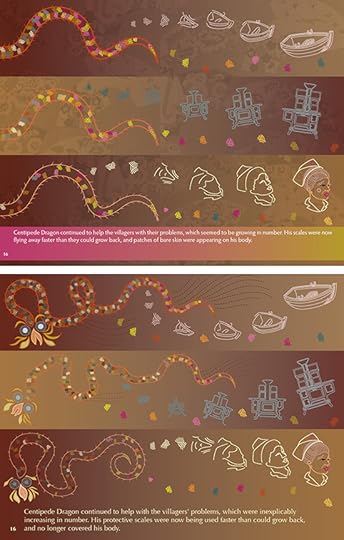
I partly agree with the “move on” advice. But instead of moving on to the next piece (because if one does not have a next piece, this can compound one's discouragement), move on to the next round of submissions. What could be better than to see on your to-do list, “Go to Barnes and Noble, sit on floor, look through latest end-cap children’s books;” or, “Go to indie bookstore for children’s story time,” or “Go to event featuring so-and-so author or illustrator.” These are no-brainer “to-do’s”.
In my case, I moved on to working on one element in an illustration that wasn’t totally satisfactory. When I was roughing out this image to show Centipede Dragon getting sick, my medical illustrator training taught me that when highlighting a difference over time (or with different parameters), keep everything else in the scene constant. So I copied and pasted the same tail image three times, only with fewer and fewer scales on each successive scenario, to convey the idea that as he’s frantically helping, his scales are rapidly disappearing.
In further developing his character, I realized I hadn't given him much variation in facial expression throughout the book. This makes him somewhat flat, and when you develop a bond with a character, it’s because you get to KNOW him/her through his/her thoughts/feelings. But if Centipede Dragon doesn’t talk, how else can you bond with him, unless I show you how he’s feeling?
So when you move on, cone down your goal to one accomplish-able thing at a time. I swear it will make it easier to tackle the larger things.

Published on April 23, 2015 14:29
April 10, 2015
Centipede Dragon comes to Alexandria City!
Thanks to the Charles E. Beatley Library for adding Centipede Dragon A Benevolent Creature to your children's collection! Now, people of the city of Alexandria, RUN over to 5005 Duke St. and check it out/ request it!


Published on April 10, 2015 05:00
April 7, 2015
The Waiting Game
You’ve gotten your manuscript, cover letter and optional dummy PERFECT, you’ve selected your publishing companies, and mailed off your submissions. Now, you wait.
All your proofing, revising, editing and re-editing, your long hours of researching the publishing companies and getting to know the industry more intimately, all the careful, loving, dedication you’ve poured into your work, and all that’s left is to wait for them to determine the fate of your book. You wait 2, 3, maybe even 6 months, that you actually forget to whom you’ve submitted and when the respective waiting period is over. But when you do remember, the last days of the wait are the toughest.
When the waiting period has come and gone and you’ve heard nothing, sometimes you give them a few extra days, in case their offices flooded, caught fire, or have been vandalized by a giant, enraged ape. Anything that might’ve prevented them from getting to your manuscript. Then the realization hits: they didn’t want your book. What do you do now?
You move on to the next round.
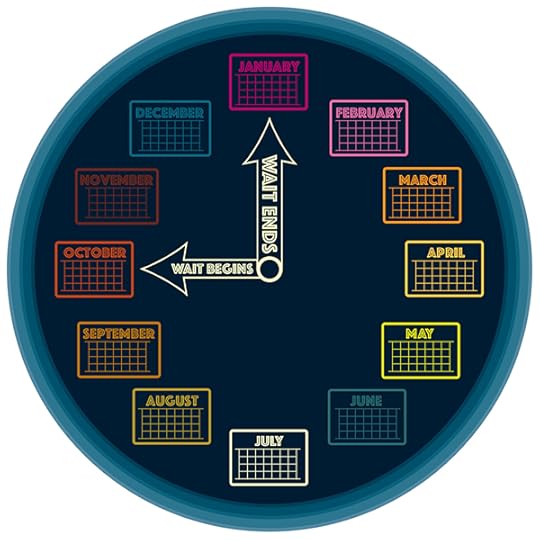
All your proofing, revising, editing and re-editing, your long hours of researching the publishing companies and getting to know the industry more intimately, all the careful, loving, dedication you’ve poured into your work, and all that’s left is to wait for them to determine the fate of your book. You wait 2, 3, maybe even 6 months, that you actually forget to whom you’ve submitted and when the respective waiting period is over. But when you do remember, the last days of the wait are the toughest.
When the waiting period has come and gone and you’ve heard nothing, sometimes you give them a few extra days, in case their offices flooded, caught fire, or have been vandalized by a giant, enraged ape. Anything that might’ve prevented them from getting to your manuscript. Then the realization hits: they didn’t want your book. What do you do now?
You move on to the next round.

Published on April 07, 2015 05:21
March 31, 2015
Selecting a publisher for manuscript submission
I want to re-visit the subject on how to select the publishing companies you submit your work to begun in Dec 2nd’s post, because this was rather tricky to address as this choice is so individual and particular to YOUR work.
I don’t think it’s entirely fair to leave this all-important decision to the hungry, idealistic, aspiring author/illustrator. All publishers are trying to publish a Caldecott winner. Who within the organization has the final say is highly variable. Publishing companies have such different editorial hierarchies; we have heard assistant editors speak about how many levels they themselves in their organizations that they must push a book through to a deal. Then there are other editors where the buck stops with them. Know the hierarchy before you submit; SCBWI membership gives you an inside scoop on this.
Publishing companies are inundated with submissions, a lot of them are from those who do NOT do any homework into the company, submit sloppy work or unsolicited when they only accept solicited. These are among the many reasons why submission guidelines have become so voluminous and strict.
To begin, target maybe 5 publishing companies that publish the books you personally like. Chances are, the artistic or writing style you gravitate to may already be in line with the types of books on a publisher’s book list. Go directly to their submission guidelines on their official website, and look for 2 main things: whether they accept un-agented (unsolicited, unless you have an agent) manuscripts; and if they will accept a multi-submission or want an exclusive submission.
SCBWI conferences will put your in a room with these editors whom you can then approach (beware that hundreds of others will have the same idea as you). Try an agent to get your book in front of those companies that do not accept unsolicited manuscripts. But frankly, NOTHING replaces knowing the industry. You should know what the top 5 best selling books are, as well as which ones won Caldecott the previous year. You should be able to rattle off the movers and shakers in this industry, just as you would for any professional industry you aspire to, or already in.
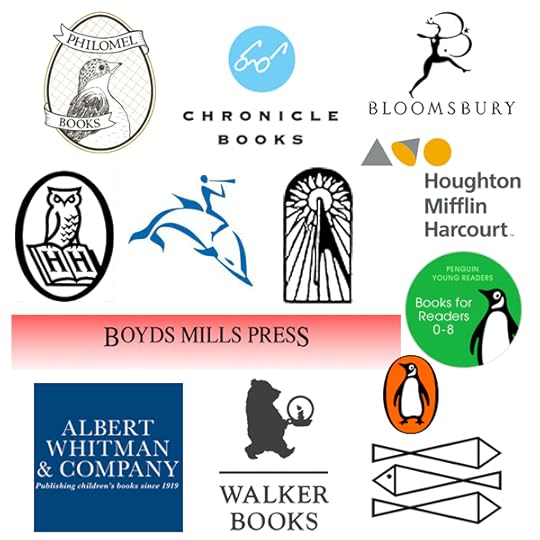
I don’t think it’s entirely fair to leave this all-important decision to the hungry, idealistic, aspiring author/illustrator. All publishers are trying to publish a Caldecott winner. Who within the organization has the final say is highly variable. Publishing companies have such different editorial hierarchies; we have heard assistant editors speak about how many levels they themselves in their organizations that they must push a book through to a deal. Then there are other editors where the buck stops with them. Know the hierarchy before you submit; SCBWI membership gives you an inside scoop on this.
Publishing companies are inundated with submissions, a lot of them are from those who do NOT do any homework into the company, submit sloppy work or unsolicited when they only accept solicited. These are among the many reasons why submission guidelines have become so voluminous and strict.
To begin, target maybe 5 publishing companies that publish the books you personally like. Chances are, the artistic or writing style you gravitate to may already be in line with the types of books on a publisher’s book list. Go directly to their submission guidelines on their official website, and look for 2 main things: whether they accept un-agented (unsolicited, unless you have an agent) manuscripts; and if they will accept a multi-submission or want an exclusive submission.
SCBWI conferences will put your in a room with these editors whom you can then approach (beware that hundreds of others will have the same idea as you). Try an agent to get your book in front of those companies that do not accept unsolicited manuscripts. But frankly, NOTHING replaces knowing the industry. You should know what the top 5 best selling books are, as well as which ones won Caldecott the previous year. You should be able to rattle off the movers and shakers in this industry, just as you would for any professional industry you aspire to, or already in.

Published on March 31, 2015 05:20

